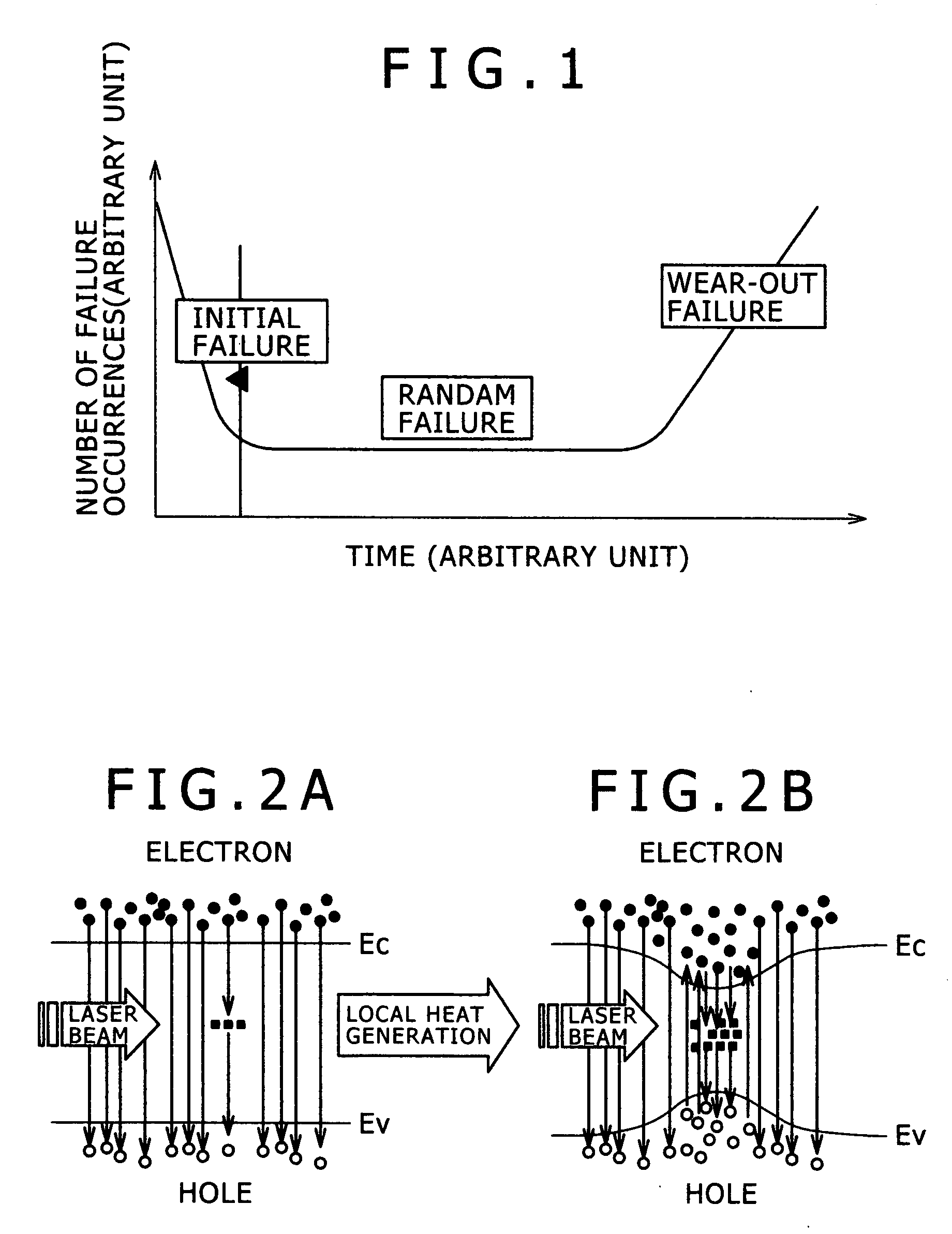Method of manufacturing semiconductor laser for communication, semiconductor laser for communication and optical transmission module
a semiconductor laser and communication technology, applied in semiconductor lasers, semiconductor/solid-state device testing/measurement, instruments, etc., can solve the problems of inability to fully explain the failure mode of communication lasers using active materials with relatively many crystal defects, and no thorough study of screening test conditions included in the manufacturing process of ingaalas lasers, etc., to achieve high-reliability communication lasers
- Summary
- Abstract
- Description
- Claims
- Application Information
AI Technical Summary
Benefits of technology
Problems solved by technology
Method used
Image
Examples
embodiment 1
[0024] A first embodiment will be described with reference to FIGS. 2 to 8. Here, FIG. 2 is a view illustrating an initial failure mode due to the amount of optical output. FIG. 3 is a view illustrating the relation between the input power and the optical output (I-L characteristic) with temperature as a parameter. FIG. 4 is a view illustrating optical output dependence on optical degradation time. FIG. 5 is a cross-sectional view of a semiconductor laser in an optical axis direction. FIG. 6 is a perspective partial cross-sectional view of the semiconductor laser in an optical axis direction. FIG. 7 includes views illustrating a screening step of a semiconductor laser diode. FIG. 8 is a functional block diagram of an optical transmission module.
[0025] In FIG. 2, in a semiconductor laser using InGaAlAs as an active layer material, the nonradiative recombination and energy bandwidth reduction, or the positive feedback phenomenon of optical absorption, occurs through the interband tra...
embodiment 2
[0039] Referring to FIGS. 9, 10 and FIG. 7, a description will be made of a case in which the above described screening step was applied to the manufacturing process of a buried-heterostructure Fabry-Perot semiconductor laser diode for a wavelength of 1.3 μm band. Here, FIG. 9 is across-sectional view of a semiconductor laser in an optical axis direction. FIG. 10 is a perspective partial cross-sectional view of the semiconductor laser in an optical axis direction.
[0040] In FIG. 9, a buffer layer 201 (n-type InP, 1.5E18 cmˆ-3, 0.5 μm), an optical guide layer 202 (n-type InGaAlAs layer, 2E18 cmˆ-3, 0.1 μm), a multiple quantum well active layer 203 (well / barrier of InGaAlAs: 7 cycles, thickness 0.21 μm), an optical guide layer 204 (p-type InGaAlAs, 3E17 cmˆ-3, 0.1 μm)), an InAlAs clad layer 205 (p-type InAlAs, 8E17 cmˆ-3, 0.1 μm), an InP clad layer 209 (p-type InP, 1E18 cmˆ-3, 1.4 μm), and a contact layer 210 (p-type InGaAs, 1E19 cmˆ-3, 0.15 μm) were crystal grown sequentially on an I...
embodiment 3
[0044] Referring to FIGS. 11, 12 and FIG. 7, a description will be made of the manufacturing process of a surface emitting semiconductor laser diode for a wavelength of 1.3 m band. FIG. 11 is a cross-sectional view of a surface emitting semiconductor laser. FIG. 12 is a perspective partial cross-sectional view of the surface emitting semiconductor laser in an optical axis direction.
[0045] As shown in FIG. 11, a buffer layer 302 (n-type InP layer, 1E18 cmˆ-3, 0.2 μm), a semiconductor reflection mirror 303 (n-type InAlAs / InGaAlAs layer, 1E18 cmˆ-3, 42-cycle structure of λ / 4 film thickness each), a lower contact layer 352 (n-type InP layer, 5E17 cmˆ-3, 0.2 μm), a clad layer 353 (n-type InAlAs layer, 5E17 cmˆ-3, 0.2 μm), an MQW layer 354 (well / barrier of InGaAlAs: 7 cycles, thickness 0.2 μm), a clad layer 355 (p-type InAlAs layer, 5E17 cmˆ-3, 0.7 μm), and a tunnel junction layer 356 (p+-InGaAlAs / n+InGaAs layer, 3E19 cmˆ-3, 20 nm / 12 nm) were crystal grown sequentially on an InP substrat...
PUM
 Login to View More
Login to View More Abstract
Description
Claims
Application Information
 Login to View More
Login to View More - R&D
- Intellectual Property
- Life Sciences
- Materials
- Tech Scout
- Unparalleled Data Quality
- Higher Quality Content
- 60% Fewer Hallucinations
Browse by: Latest US Patents, China's latest patents, Technical Efficacy Thesaurus, Application Domain, Technology Topic, Popular Technical Reports.
© 2025 PatSnap. All rights reserved.Legal|Privacy policy|Modern Slavery Act Transparency Statement|Sitemap|About US| Contact US: help@patsnap.com



